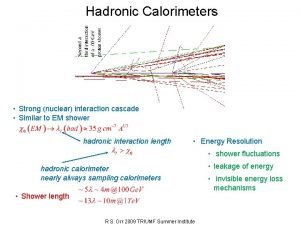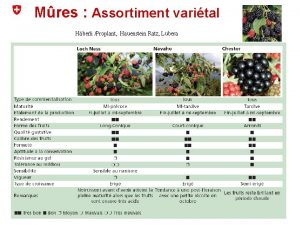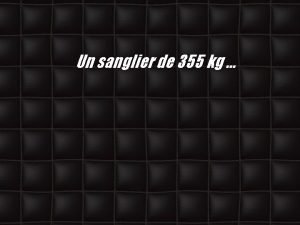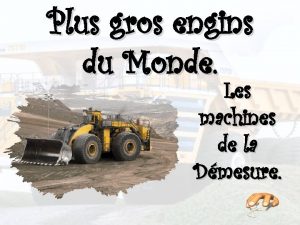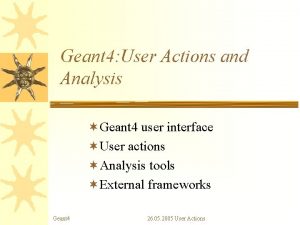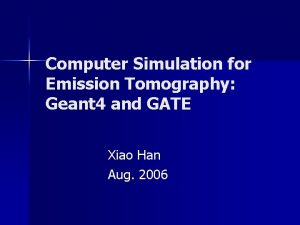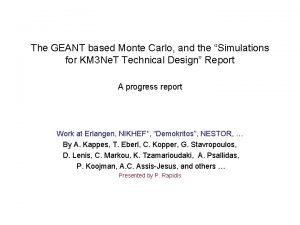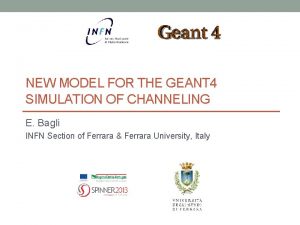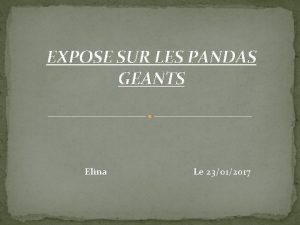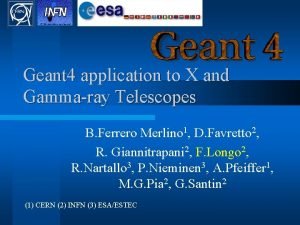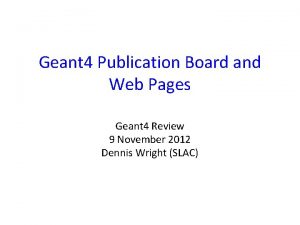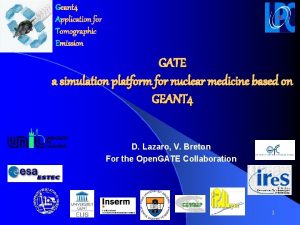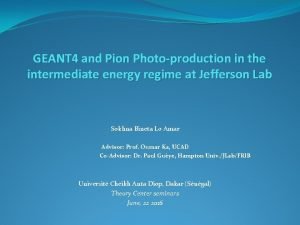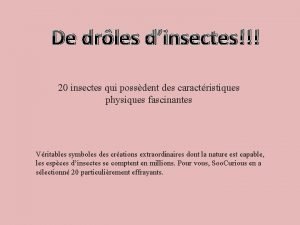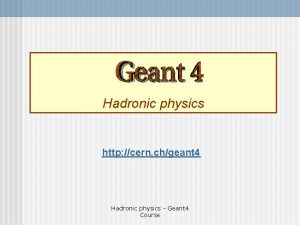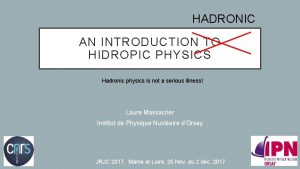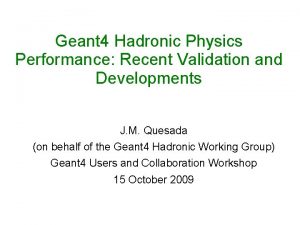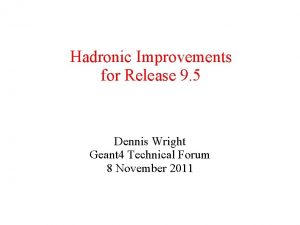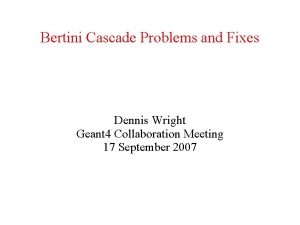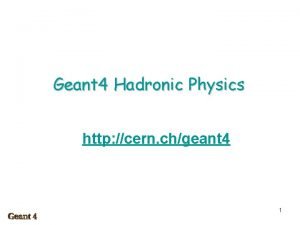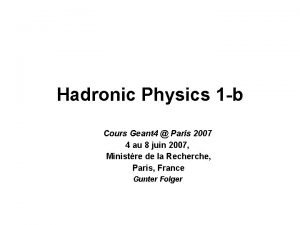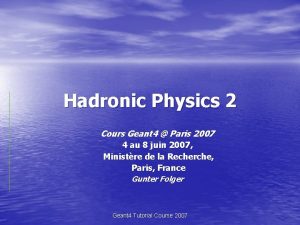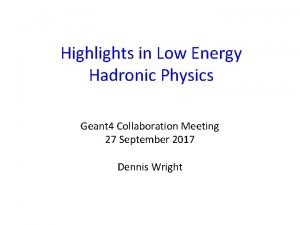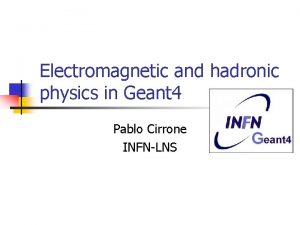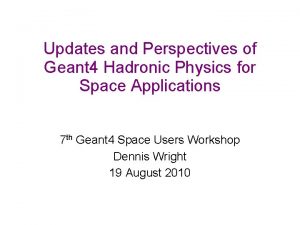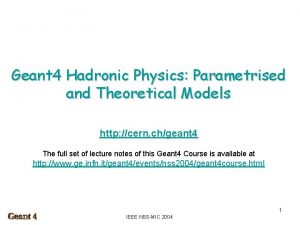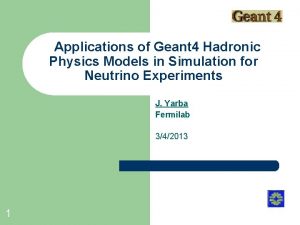Recent Geant 4 Hadronic Physics Features Dennis Wright


















- Slides: 18

Recent Geant 4 Hadronic Physics Features Dennis Wright Geant 4 Technical Forum 16 November 2010

Outline • • • Introduction A review of major improvements in 9. 3 (2009) Features in 9. 4 beta (June 2010) New features in 9. 4 (December 2010) Plans for 2011

Introduction • Work of the hadronic group over the past 3 -4 years has been driven by requests from LHC detectors – better hadronic shower shapes – better energy response and resolution • good progress, but still work to do – improved kaon interactions • models extended to handle this – ion-ion interactions • development ongoing – anti-nucleon and anti-ion reactions • development program recently begun

Atlas Tile Cal Longitudinal Shower Shape for Incident Pions

Summary of Major Improvements in 9. 3 • FTF model – added excitation energy calculation and introduced Reggeon cascading • • resulted in extension of applicability to lower energies smoother transition to cascade possible – improved pion absorption • Bertini-style cascade – full review of pi-nucleon and nucleon-nucleon partial cross sections • many corrections made

Summary of Major Improvements in 9. 3 • Precompound and de-excitation models – GEM model fixed and re-introduced – replaced old-style emission probabilities (based on pre-1960's data) with new parameterization • Binary. Light. Ion cascade – improvements to allow de-excitation of smaller fragments • QMD model (ion-ion collisions) extended up to 5 Ge. V/n • CHIPS models extended to all particles, all energies – validation in progress, some problems found

Features in Geant 4 9. 4 beta • Extension of FTF model down to 3 -5 Ge. V for hadron-nucleus scattering – tuned parameters of Reggeon cascading – improved fragmentation of small-mass strings • As a result, improved behavior below 8 Ge. V – smoother transition from cascade to string model in physics lists (e. g. FTFP_BERT) – transition from cascade to string model now possible at lower energies • can now consider using Binary cascade as alternate to Bertini

Features in Geant 4 9. 4 beta • Bertini-style cascade – almost all energy-momentum non-conservation removed – old pion-nucleon and nucleon-nucleon angular distributions replaced (for two-body final states) – reduction of memory churn by factor ~10 • Partially completed transition to using integer A and Z exclusively in hadronic code – now require use of specific isotopes – no effective Z or average A allowed • can no longer use materials with average Z and A

Features in Geant 4 9. 4 beta • Extensive improvements in G 4 Precompound model and de-excitation code – hybrid use of Weisskopf-Ewing and GEM models to improve nuclear fragment spectra from decay – improved inverse capture cross sections – numerous bug fixes and improvements in logic – enable use of multi-fragmentation model

Precompound and De-excitation Models vs. IAEA Data for p+Au -> X

New Features in Geant 4 9. 4 • Faster neutron capture model – includes some of the detail found in HP neutron models • old GHEISHA-based model too simple • high precision neutron model too slow • ENDL-based (Livermore) precision neutron models – alternative to HP models • more isotopes than HP models • based on Livermore neutron DB • not expected to be any faster

n + Fe Cross Section Data vs CHIPS, LHEP, and Fast. HP Parameterizations

New Features in Geant 4 9. 4 • p, n, d, t, 3 He, - nucleus cross sections – first step in expanding hadronic models to handle incident anti-nucleons and anti-light ions • Glauber-Gribov parameterization • CHIPS cross sections • Interfaces of cascade models to G 4 Precompound model – allows our best de-excitation model to be used in a uniform way with existing cascade codes • Bertini-style cascade • already used by Binary cascade

New Features in Geant 4 9. 4 • Nucleus-nucleus collisions – nucleus-nucleus cross sections • Glauber-Gribov-parameterized cross sections cover targets and projectiles of all A • projectile energy down to ~1 Me. V and up to ~Te. V

Plans for 2011 • Shower shape and calorimeter response improvements – develop and validate new physics lists to exploit recent model extensions – try new implementation of nuclear trailing effect in Bertini cascade • Completed implementation of hadronic cross section de-design – developed plan last year to treat large number of cross section data sets uniformly – will allow smoother joining of one set to another

Plans for 2011 • Anti-nucleon, anti-nucleus extensions – Bertini-style cascade – FTF model • Kaon oscillation, cross section improvement for kaons, hyperons • Installation of CIEMAT alternative to G 4 NDL (high precision neutron libraries) – use of ENDF-VII database, but processed differently than G 4 NDL

Plans for 2011 • Add initial and final state clustering models to Bertini – to improve light ion production at cascade energies • Interface of G 4 Precompound and de-excitation to INCL cascade

Plans for 2011 • Nucleus-nucleus scattering – currently our models do not perform well above ~5 Ge. V/c • – extend them: FTF, RQMD low energy scattering • • • current models do not go below ~100 Me. V will then have complete coverage of nucleus A and incident energy develop and validate new physics lists to use new ion-ion models and cross sections

